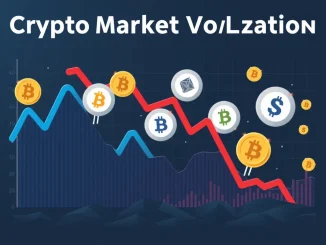
The crypto market just delivered a jolt, with a staggering $225 million worth of futures positions liquidated in a single hour. This sudden event underscores the inherent risks and volatility present in cryptocurrency trading, particularly for those utilizing leverage in the futures market.
What is Crypto Liquidation?
Understanding crypto liquidation is key to grasping the impact of this event. Liquidation occurs when a trader’s leveraged position is forcefully closed by an exchange. This happens because the trader’s margin (the collateral used to open the position) falls below a certain level required by the exchange to keep the trade open. Essentially, the market moved against the trader’s bet, and they ran out of funds to cover potential losses, leading the exchange to close the position automatically to prevent further losses for both the trader and the exchange.
Understanding Futures Liquidation Events
The $225 million figure represents a significant amount of futures liquidation. These events are common in volatile markets but the speed and size of this particular liquidation highlight intense price movement in a short period. When liquidations cascade, they can exacerbate price swings. As positions are closed, it often involves the forced selling (for long positions) or buying (for short positions) of the underlying asset, adding pressure to the market price and potentially triggering more liquidations.
Over a slightly longer timeframe, the past 24 hours saw a total of $515 million in cryptocurrency futures liquidated across major trading platforms. This broader figure indicates sustained pressure or multiple price swings over the day, catching many leveraged traders off guard.
Navigating Crypto Market Volatility
Events like this are stark reminders of crypto market volatility. While volatility can present opportunities for traders, it also carries significant risks, especially when leverage is involved. High leverage magnifies both potential profits and losses. A small adverse price movement can quickly lead to a margin call and subsequent liquidation.
Key takeaways from liquidation events:
- Leverage Risk: Higher leverage increases the likelihood of liquidation.
- Market Speed: Crypto markets move fast; prices can change drastically in minutes.
- Cascading Effects: One liquidation can trigger others, amplifying price moves.
- Exchange Differences: Liquidation processes and margin requirements can vary by exchange.
Why Bitcoin Futures Matter
While the report doesn’t specify which cryptocurrencies were most affected, Bitcoin futures typically represent the largest portion of the crypto futures market. Therefore, a significant liquidation event like this often indicates substantial liquidations in Bitcoin and potentially Ethereum futures, alongside other altcoins. Bitcoin’s price movements often set the tone for the broader market, making its futures market a key indicator of sentiment and leverage levels.
Actionable Insights for Traders
For those trading cryptocurrency futures or considering it, managing risk is paramount:
- Use Leverage Cautiously: Understand the liquidation price associated with your leverage level.
- Set Stop-Loss Orders: These can help limit potential losses and prevent liquidation.
- Monitor Margin Levels: Keep track of your margin health to avoid unexpected closures.
- Stay Informed: Pay attention to market news and price trends.
- Don’t Overcommit: Only trade with capital you can afford to lose.
Conclusion
The rapid liquidation of $225 million in crypto futures within an hour serves as a potent reminder of the dynamic and often unforgiving nature of leveraged trading in the cryptocurrency market. Coupled with the $515 million liquidated over 24 hours, it highlights periods of significant price discovery and risk realization for traders. While the market continues to evolve, understanding the mechanics and risks associated with futures and leverage is crucial for anyone participating in this high-stakes environment. Always prioritize risk management to navigate crypto market volatility effectively.



